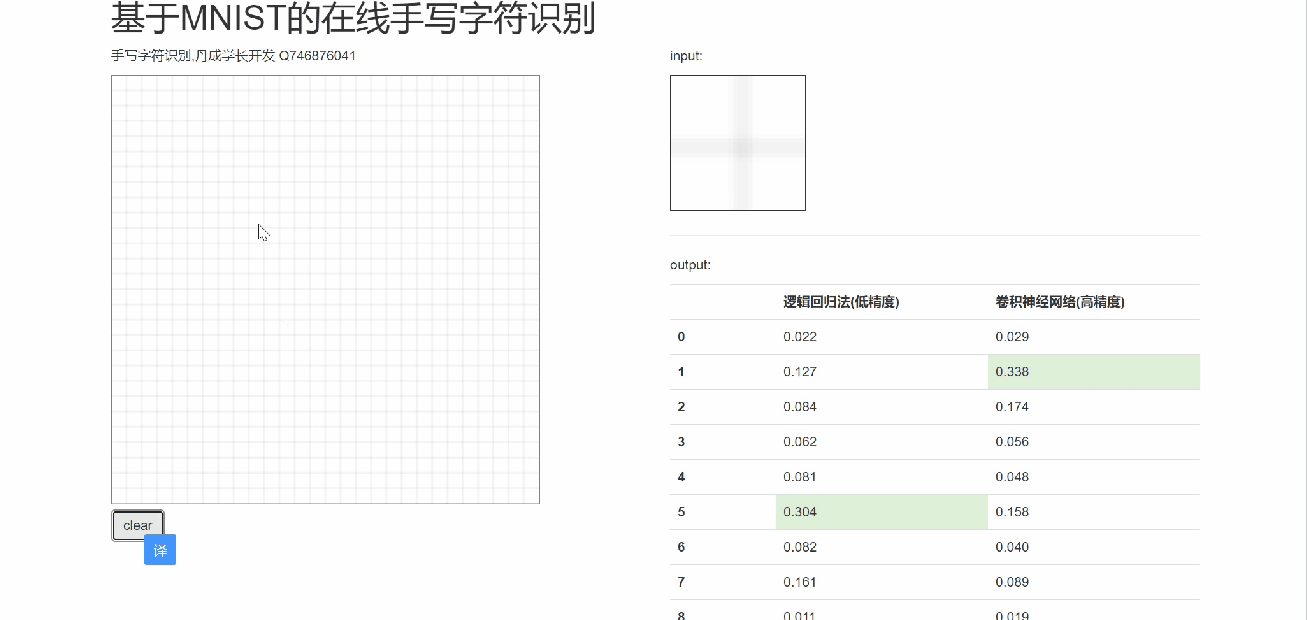软件杯 卷积神经网络手写字符识别 - 深度学习
文章目录
0 前言
🔥 优质竞赛项目系列,今天要分享的是
🚩 卷积神经网络手写字符识别 - 深度学习
该项目较为新颖,适合作为竞赛课题方向,学长非常推荐!
🥇学长这里给一个题目综合评分(每项满分5分)
- 难度系数:3分
- 工作量:3分
- 创新点:4分
🧿 更多资料, 项目分享:
https://gitee.com/dancheng-senior/postgraduate

1 简介
该设计学长使用python基于TensorFlow设计手写数字识别算法,并编程实现GUI界面,构建手写数字识别系统。
这是学长做的深度学习demo,大家可以用于毕业设计。
这里学长不会以论文的形式展现,而是以编程实战完成深度学习项目的角度去描述。
项目要求:主要解决的问题是手写数字识别,最终要完成一个识别系统。
设计识别率高的算法,实现快速识别的系统。
2 LeNet-5 模型的介绍
学长实现手写数字识别,使用的是卷积神经网络,建模思想来自LeNet-5,如下图所示:

2.1 结构解析
这是原始的应用于手写数字识别的网络,我认为这也是最简单的深度网络。
LeNet-5不包括输入,一共7层,较低层由卷积层和最大池化层交替构成,更高层则是全连接和高斯连接。
LeNet-5的输入与BP神经网路的不一样。这里假设图像是黑白的,那么LeNet-5的输入是一个32*32的二维矩阵。同
时,输入与下一层并不是全连接的,而是进行稀疏连接。本层每个神经元的输入来自于前一层神经元的局部区域(5×5),卷积核对原始图像卷积的结果加上相应的阈值,得出的结果再经过激活函数处理,输出即形成卷积层(C层)。卷积层中的每个特征映射都各自共享权重和阈值,这样能大大减少训练开销。降采样层(S层)为减少数据量同时保存有用信息,进行亚抽样。
2.2 C1层
第一个卷积层(C1层)由6个特征映射构成,每个特征映射是一个28×28的神经元阵列,其中每个神经元负责从5×5的区域通过卷积滤波器提取局部特征。一般情况下,滤波器数量越多,就会得出越多的特征映射,反映越多的原始图像的特征。本层训练参数共6×(5×5+1)=156个,每个像素点都是由上层5×5=25个像素点和1个阈值连接计算所得,共28×28×156=122304个连接。
2.3 S2层
S2层是对应上述6个特征映射的降采样层(pooling层)。pooling层的实现方法有两种,分别是max-pooling和mean-
pooling,LeNet-5采用的是mean-
pooling,即取n×n区域内像素的均值。C1通过2×2的窗口区域像素求均值再加上本层的阈值,然后经过激活函数的处理,得到S2层。pooling的实现,在保存图片信息的基础上,减少了权重参数,降低了计算成本,还能控制过拟合。本层学习参数共有1*6+6=12个,S2中的每个像素都与C1层中的2×2个像素和1个阈值相连,共6×(2×2+1)×14×14=5880个连接。
S2层和C3层连接
S2层和C3层的连接比较复杂。C3卷积层是由16个大小为10×10的特征映射组成的,当中的每个特征映射与S2层的若干个特征映射的局部感受野(大小为5×5)相连。其中,前6个特征映射与S2层连续3个特征映射相连,后面接着的6个映射与S2层的连续的4个特征映射相连,然后的3个特征映射与S2层不连续的4个特征映射相连,最后一个映射与S2层的所有特征映射相连。
此处卷积核大小为5×5,所以学习参数共有6×(3×5×5+1)+9×(4×5×5+1)+1×(6×5×5+1)=1516个参数。而图像大小为28×28,因此共有151600个连接。
S4层是对C3层进行的降采样,与S2同理,学习参数有16×1+16=32个,同时共有16×(2×2+1)×5×5=2000个连接。
C5层是由120个大小为1×1的特征映射组成的卷积层,而且S4层与C5层是全连接的,因此学习参数总个数为120×(16×25+1)=48120个。
2.4 F6与C5层
F6是与C5全连接的84个神经元,所以共有84×(120+1)=10164个学习参数。
卷积神经网络通过通过稀疏连接和共享权重和阈值,大大减少了计算的开销,同时,pooling的实现,一定程度上减少了过拟合问题的出现,非常适合用于图像的处理和识别。
3 写数字识别算法模型的构建
3.1 输入层设计
输入为28×28的矩阵,而不是向量。

3.2 激活函数的选取
Sigmoid函数具有光滑性、鲁棒性和其导数可用自身表示的优点,但其运算涉及指数运算,反向传播求误差梯度时,求导又涉及乘除运算,计算量相对较大。同时,针对本文构建的含有两层卷积层和降采样层,由于sgmoid函数自身的特性,在反向传播时,很容易出现梯度消失的情况,从而难以完成网络的训练。因此,本文设计的网络使用ReLU函数作为激活函数。

3.3 卷积层设计
学长设计卷积神经网络采取的是离散卷积,卷积步长为1,即水平和垂直方向每次运算完,移动一个像素。卷积核大小为5×5。
3.4 降采样层
学长设计的降采样层的pooling方式是max-pooling,大小为2×2。
3.5 输出层设计
输出层设置为10个神经网络节点。数字0~9的目标向量如下表所示:

4 网络模型的总体结构

5 部分实现代码
使用Python,调用TensorFlow的api完成手写数字识别的算法。
注:我的程序运行环境是:Win10,python3.。
当然,也可以在Linux下运行,由于TensorFlow对py2和py3兼容得比较好,在Linux下可以在python2.7中运行。
#!/usr/bin/env python2
# -*- coding: utf-8 -*-
"""
@author: 丹成学长 Q746876041
"""
#import modules
import numpy as np
import matplotlib.pyplot as plt
#from sklearn.metrics import confusion_matrix
import tensorflow as tf
import time
from datetime import timedelta
import math
from tensorflow.examples.tutorials.mnist import input_data
def new_weights(shape):
return tf.Variable(tf.truncated_normal(shape,stddev=0.05))
def new_biases(length):
return tf.Variable(tf.constant(0.1,shape=length))
def conv2d(x,W):
return tf.nn.conv2d(x,W,strides=[1,1,1,1],padding='SAME')
def max_pool_2x2(inputx):
return tf.nn.max_pool(inputx,ksize=[1,2,2,1],strides=[1,2,2,1],padding='SAME')
#import data
data = input_data.read_data_sets("./data", one_hot=True) # one_hot means [0 0 1 0 0 0 0 0 0 0] stands for 2
print("Size of:")
print("--Training-set:\t\t{}".format(len(data.train.labels)))
print("--Testing-set:\t\t{}".format(len(data.test.labels)))
print("--Validation-set:\t\t{}".format(len(data.validation.labels)))
data.test.cls = np.argmax(data.test.labels,axis=1) # show the real test labels: [7 2 1 ..., 4 5 6], 10000values
x = tf.placeholder("float",shape=[None,784],name='x')
x_image = tf.reshape(x,[-1,28,28,1])
y_true = tf.placeholder("float",shape=[None,10],name='y_true')
y_true_cls = tf.argmax(y_true,dimension=1)
# Conv 1
layer_conv1 = {"weights":new_weights([5,5,1,32]),
"biases":new_biases([32])}
h_conv1 = tf.nn.relu(conv2d(x_image,layer_conv1["weights"])+layer_conv1["biases"])
h_pool1 = max_pool_2x2(h_conv1)
# Conv 2
layer_conv2 = {"weights":new_weights([5,5,32,64]),
"biases":new_biases([64])}
h_conv2 = tf.nn.relu(conv2d(h_pool1,layer_conv2["weights"])+layer_conv2["biases"])
h_pool2 = max_pool_2x2(h_conv2)
# Full-connected layer 1
fc1_layer = {"weights":new_weights([7*7*64,1024]),
"biases":new_biases([1024])}
h_pool2_flat = tf.reshape(h_pool2,[-1,7*7*64])
h_fc1 = tf.nn.relu(tf.matmul(h_pool2_flat,fc1_layer["weights"])+fc1_layer["biases"])
# Droupout Layer
keep_prob = tf.placeholder("float")
h_fc1_drop = tf.nn.dropout(h_fc1,keep_prob)
# Full-connected layer 2
fc2_layer = {"weights":new_weights([1024,10]),
"biases":new_weights([10])}
# Predicted class
y_pred = tf.nn.softmax(tf.matmul(h_fc1_drop,fc2_layer["weights"])+fc2_layer["biases"]) # The output is like [0 0 1 0 0 0 0 0 0 0]
y_pred_cls = tf.argmax(y_pred,dimension=1) # Show the real predict number like '2'
# cost function to be optimized
cross_entropy = -tf.reduce_mean(y_true*tf.log(y_pred))
optimizer = tf.train.AdamOptimizer(learning_rate=1e-4).minimize(cross_entropy)
# Performance Measures
correct_prediction = tf.equal(y_pred_cls,y_true_cls)
accuracy = tf.reduce_mean(tf.cast(correct_prediction,"float"))
with tf.Session() as sess:
init = tf.global_variables_initializer()
sess.run(init)
train_batch_size = 50
def optimize(num_iterations):
total_iterations=0
start_time = time.time()
for i in range(total_iterations,total_iterations+num_iterations):
x_batch,y_true_batch = data.train.next_batch(train_batch_size)
feed_dict_train_op = {x:x_batch,y_true:y_true_batch,keep_prob:0.5}
feed_dict_train = {x:x_batch,y_true:y_true_batch,keep_prob:1.0}
sess.run(optimizer,feed_dict=feed_dict_train_op)
# Print status every 100 iterations.
if i%100==0:
# Calculate the accuracy on the training-set.
acc = sess.run(accuracy,feed_dict=feed_dict_train)
# Message for printing.
msg = "Optimization Iteration:{0:>6}, Training Accuracy: {1:>6.1%}"
# Print it.
print(msg.format(i+1,acc))
# Update the total number of iterations performed
total_iterations += num_iterations
# Ending time
end_time = time.time()
# Difference between start and end_times.
time_dif = end_time-start_time
# Print the time-usage
print("Time usage:"+str(timedelta(seconds=int(round(time_dif)))))
test_batch_size = 256
def print_test_accuracy():
# Number of images in the test-set.
num_test = len(data.test.images)
cls_pred = np.zeros(shape=num_test,dtype=np.int)
i = 0
while i < num_test:
# The ending index for the next batch is denoted j.
j = min(i+test_batch_size,num_test)
# Get the images from the test-set between index i and j
images = data.test.images[i:j, :]
# Get the associated labels
labels = data.test.labels[i:j, :]
# Create a feed-dict with these images and labels.
feed_dict={x:images,y_true:labels,keep_prob:1.0}
# Calculate the predicted class using Tensorflow.
cls_pred[i:j] = sess.run(y_pred_cls,feed_dict=feed_dict)
# Set the start-index for the next batch to the
# end-index of the current batch
i = j
cls_true = data.test.cls
correct = (cls_true==cls_pred)
correct_sum = correct.sum()
acc = float(correct_sum) / num_test
# Print the accuracy
msg = "Accuracy on Test-Set: {0:.1%} ({1}/{2})"
print(msg.format(acc,correct_sum,num_test))
# Performance after 10000 optimization iterations
optimize(num_iterations=10000)
print_test_accuracy()
savew_hl1 = layer_conv1["weights"].eval()
saveb_hl1 = layer_conv1["biases"].eval()
savew_hl2 = layer_conv2["weights"].eval()
saveb_hl2 = layer_conv2["biases"].eval()
savew_fc1 = fc1_layer["weights"].eval()
saveb_fc1 = fc1_layer["biases"].eval()
savew_op = fc2_layer["weights"].eval()
saveb_op = fc2_layer["biases"].eval()
np.save("savew_hl1.npy", savew_hl1)
np.save("saveb_hl1.npy", saveb_hl1)
np.save("savew_hl2.npy", savew_hl2)
np.save("saveb_hl2.npy", saveb_hl2)
np.save("savew_hl3.npy", savew_fc1)
np.save("saveb_hl3.npy", saveb_fc1)
np.save("savew_op.npy", savew_op)
np.save("saveb_op.npy", saveb_op)
运行结果显示:测试集中准确率大概为99.2%。

查看混淆矩阵

6 在线手写识别


7 最后
🧿 更多资料, 项目分享:
https://gitee.com/dancheng-senior/postgraduate
原文地址:https://blog.csdn.net/m0_43533/article/details/136557378
免责声明:本站文章内容转载自网络资源,如本站内容侵犯了原著者的合法权益,可联系本站删除。更多内容请关注自学内容网(zxcms.com)!
